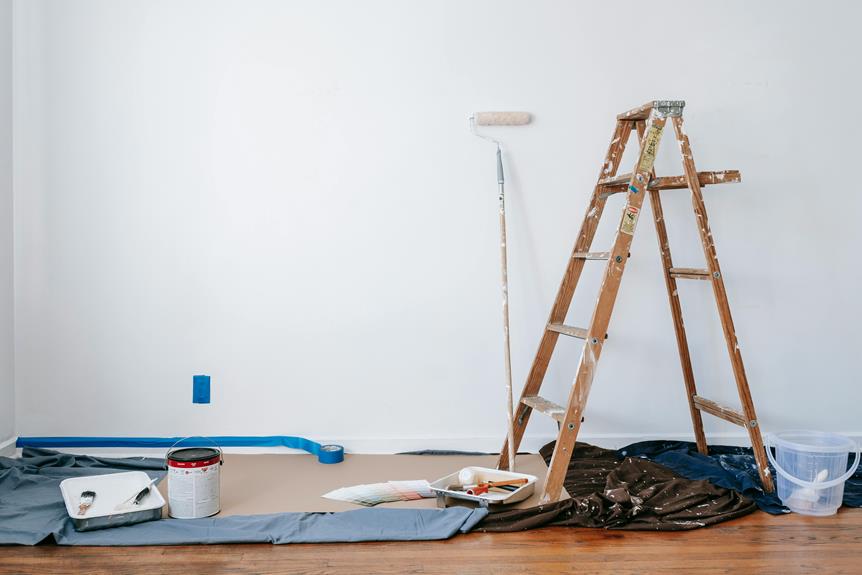When you notice your favorite fabric starting to lose its vibrancy, it's easy to feel frustrated. But before you give up on it, consider that restoring faded fabrics at home is often simpler than you think. You'll need to identify the fabric type and gather a few common ingredients, both natural and chemical, that can work wonders. Understanding the right approach can make all the difference, especially when it comes to ensuring lasting results. So, what steps should you take first to revive your textiles effectively?
Table of Contents
Key Takeaways
- Identify the fabric type using a burn test to select the appropriate restoration method and products.
- Prepare a well-lit workspace with organized supplies like mild detergent, vinegar, and soft brushes for efficient restoration.
- Use natural remedies like baking soda and vinegar during washing to lift stains and enhance colors.
- Consider dyeing faded fabrics with compatible dyes, ensuring to test a small area first for color accuracy.
Assessing the Fabric Type
To effectively restore faded fabrics, you should first identify the type of material you're dealing with. Different fabrics react differently to restoration techniques, so knowing whether you have cotton, polyester, silk, or wool is crucial. Take a close look at the label or perform a burn test if necessary. For example, cotton will burn and turn to ash, while synthetic fibers tend to melt.
Once you've identified the fabric, consider its color and weave. Some fabrics have dyes that are more prone to fading, while others may hold color better. This knowledge will help you choose the right restoration method. If you're working with delicate materials like silk, you'll need to handle them with care, as aggressive treatments can cause further damage.
Also, think about the fabric's age and wear. Vintage fabrics, for instance, might require gentler restoration techniques compared to newer materials. By assessing the type of fabric, you're setting yourself up for a successful restoration process. Knowing your material will guide you in selecting the appropriate products and methods, ensuring you bring your faded fabrics back to life effectively.
Prepping for Restoration
After identifying the fabric type, it's time to gather the necessary supplies and create a workspace that allows for effective restoration. Choose a well-lit area where you can easily move around and have access to all your materials.
Here's a quick checklist of what you might need for prepping:
| Supplies | Purpose |
|---|---|
| Mild detergent | Cleans the fabric before restoration |
| Soft brushes or sponges | Applies solutions without damaging fibers |
| White vinegar or baking soda | Natural agents for restoration |
Make sure to have a clean surface to work on, free from clutter. Lay down some old towels or a drop cloth to protect your workspace from spills or stains. Gather all your supplies in one place so you won't waste time searching for items during the restoration process. This preparation not only helps you stay organized but also ensures that you can focus on reviving your faded fabrics without interruptions. By taking these steps, you're setting yourself up for a successful restoration journey!
Natural Remedies for Faded Fabrics
Restoring faded fabrics can be effectively achieved using natural remedies that brighten colors and rejuvenate textiles.
One simple method is using baking soda. Mix a half-cup of baking soda with your regular laundry detergent, and wash your faded items in warm water. This helps lift stains and restore vibrancy.
Another effective remedy is white vinegar. Add one cup of vinegar to the rinse cycle when washing your fabrics. The acidity of the vinegar helps break down residue and can enhance colors. For delicate fabrics, consider soaking them in a solution of equal parts water and vinegar for about 30 minutes before washing.
Lemon juice also works wonders. Combine lemon juice with water and soak your faded fabrics for an hour before washing. The natural bleaching properties of lemon can help revive colors without damaging the fabric.
Lastly, sunlight can be a natural brightener. Hang your washed fabrics outside in the sunlight for a few hours. Just be cautious with bright colors, as prolonged exposure may lead to further fading.
Chemical Solutions and Dyes
Chemical solutions and dyes can effectively revive the color of faded fabrics, offering a quick fix for textiles that have lost their vibrancy over time.
When you're ready to tackle those dull items, start by choosing the appropriate dye or fabric paint for your material. Always read the label to ensure compatibility with the fabric type.
Before you begin, wash the fabric to remove any dirt or residue, then prepare your dye according to the instructions. If you're using fabric dye, you'll typically want to submerge the item in a dye bath, ensuring it's evenly coated. Stir occasionally to achieve a uniform color. For smaller touch-ups or patterns, fabric paint can be applied with a brush or sponge.
Keep in mind that colors may look different when wet, so test a small, inconspicuous area first. After dyeing, rinse the fabric under cold water until it runs clear, then air dry it away from direct sunlight.
Preventing Future Fading
To keep your fabrics looking vibrant, incorporate simple care practices into your routine.
Start by washing your clothes in cold water, as hot water can cause colors to fade more quickly. Always use a mild detergent that's designed for colored fabrics to protect those hues.
When you dry your clothes, opt for air drying whenever possible. Direct sunlight can be harsh on fabrics, so if you must use a dryer, consider using a low heat setting.
Also, be mindful of how you store your textiles. Avoid placing them in direct sunlight for extended periods, and choose breathable storage options like cotton bags or bins. For garments, consider using padded hangers to prevent stretching and creasing.
If you frequently wear a favorite piece, consider rotating your wardrobe to minimize wear on any single item.
Lastly, treat stains immediately to prevent them from setting in, which can lead to discoloration over time.
Frequently Asked Questions
Can I Restore Faded Fabrics Without Damaging the Original Color?
Yes, you can restore faded fabrics without damaging the original color. Use gentle cleaning methods, avoid harsh chemicals, and test any restoration products on a small, inconspicuous area first to ensure safety and effectiveness.
How Long Does the Restoration Process Typically Take?
The restoration process usually takes a few hours to a couple of days, depending on the method you choose. You'll want to allow adequate time for drying and setting to ensure the best results.
Are There Specific Fabrics That Cannot Be Restored?
Yes, some fabrics like silk, velvet, or those with special finishes may not restore well. You'll want to test any restoration method on a small area first to ensure the fabric responds positively.
What Tools or Supplies Do I Need for Fabric Restoration?
You'll need a few key supplies for fabric restoration: a gentle detergent, color-safe bleach, water, sponges, fabric dye, and protective gloves. These tools will help you effectively revive and enhance your fabrics' original colors.
Is It Safe to Use These Methods on Children's Clothing?
Yes, it's generally safe to use these methods on children's clothing, but always check fabric care labels first. Test any solution on a small area to ensure it won't cause damage or discoloration before proceeding.
- Tetron Fabric for Marine Applications: Durability and Use Cases - June 18, 2025
- Tetron Fabric for Outdoor Furniture: Weather Resistance and Care - June 18, 2025
- Tetron Fabric for Wall Coverings: Style and Application Tips - June 18, 2025






